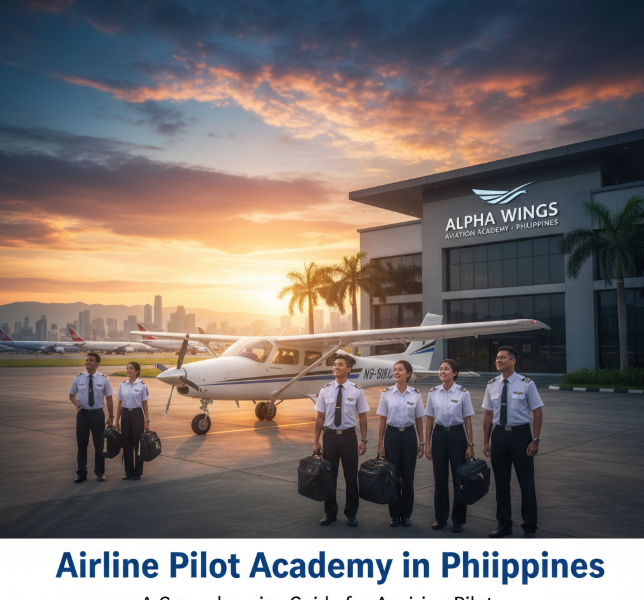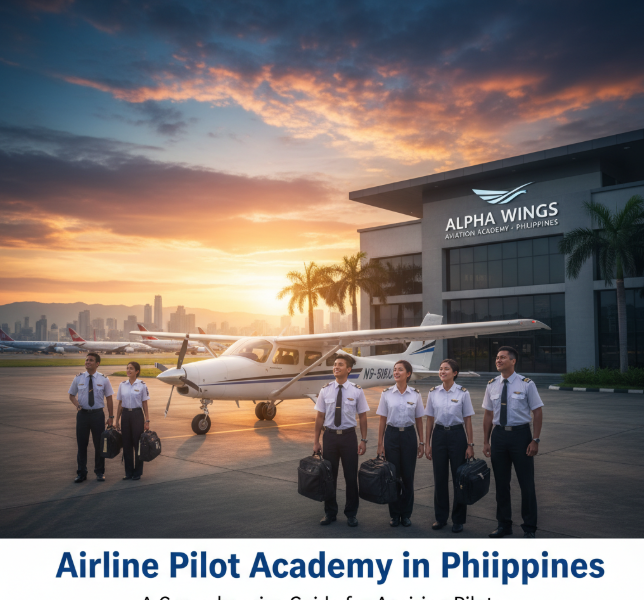
The Philippines, a beautiful archipelago with over 7,000 islands, has become an important hub for aviation in Southeast Asia. With a thriving aviation industry that encompasses commercial, military, and international sectors, the demand for trained pilots has never been higher. Aspiring aviators are increasingly looking toward the Philippines as an excellent destination to start their careers. This blog serves as a comprehensive guide to the Airline Pilot Academy in Philippines, covering essential details like pilot training, institutes, eligibility requirements, challenges, and career opportunities.
Introduction to Airline Pilot Academy in Philippines
Aviation education in the Philippines is thriving, with multiple institutions offering world-class pilot training. Whether you’re aspiring to become a commercial airline pilot or exploring other aviation-related fields, the country boasts an array of reputable pilot academies. These institutes offer rigorous training programs designed to provide students with the skills, knowledge, and practical experience required for a successful career in aviation.
What is an Airline Pilot Academy?
An Airline Pilot Academy is an educational institution that offers specialized training programs for individuals who wish to pursue a career as a commercial airline pilot. These academies provide comprehensive courses that include theoretical knowledge, flight training, and hands-on practice in simulators and aircraft. The goal is to equip students with all the necessary skills to become proficient pilots and fulfill regulatory requirements, such as obtaining a Commercial Pilot License (CPL).
Importance of Aviation in the Philippines
Aviation in the Philippines plays a vital role in connecting the archipelago to the rest of the world, supporting both the tourism industry and international trade. With its expanding airline network and increasing travel demand, the aviation sector is one of the major contributors to the country’s economic growth.
The Philippines’ Strategic Location
Due to its strategic location in Southeast Asia, the Philippines serves as a hub for both regional and international air traffic. The country’s growing air travel market and increasing international tourist arrivals have resulted in a higher demand for skilled pilots. This trend is expected to continue, making aviation careers in the Philippines even more promising.
History and Development of Aviation in the Philippines
Early Aviation History of the Philippines
The history of aviation in the Philippines dates back to the 1920s when the first air service was established between Manila and other provinces. The country’s first international airline, Philippine Airlines (PAL), was founded in 1941. PAL is currently the oldest airline in Asia and continues to play a pivotal role in the region’s aviation industry.
Milestones in Philippine Aviation
- Post-War Expansion: After World War II, the Philippines saw rapid growth in both commercial and military aviation. PAL and other private airlines began expanding their routes, connecting the Philippines to the global market.
- Modern-Day Growth: In the 21st century, the Philippines has become an important player in international aviation, with a growing fleet of modern aircraft and multiple international airlines flying in and out of major airports like Ninoy Aquino International Airport (NAIA).
Current Role of Airline Pilot Academy in Philippines
How Airline Pilot Academies Function Today
Pilot academies in the Philippines offer training programs that adhere to international aviation standards set by the International Civil Aviation Organization (ICAO). These academies provide both ground school and in-flight training, covering subjects like flight theory, navigation, meteorology, aviation regulations, and more.
Role in Civil Aviation, Defense, and Space Exploration
Airline pilot academies contribute not only to civil aviation but also to the defense sector, with many pilots graduating to serve in the Philippine Air Force (PAF). Furthermore, as the Philippines continues to develop its aviation capabilities, these academies may play an increasingly significant role in future space exploration initiatives, especially with growing interest in satellite launches and space technology.
Eligibility, Training, and Skills Required
Basic Qualifications for Pilot Training
To enroll in an airline pilot academy in the Philippines, candidates must meet certain basic requirements:
- Age: Most institutions require candidates to be at least 17 years old.
- Education: A high school diploma or equivalent is required, though some institutes may prefer candidates with a bachelor’s degree.
- Health: A medical examination is mandatory to ensure candidates meet the necessary physical standards.
- Language Proficiency: English proficiency is essential as it is the primary language of aviation communication worldwide.
Technical and Soft Skills
Aside from the basic qualifications, aspiring pilots should possess the following:
- Technical Skills: Proficiency in navigation, meteorology, aircraft systems, and flight theory.
- Soft Skills: Strong leadership, communication, and problem-solving abilities, as pilots must often make quick decisions in high-pressure situations.
Institutes, Academies, and Training Centers in Philippines
Several institutions in the Philippines provide comprehensive pilot training programs. Some of the most notable ones include:
- Philippine State College of Aeronautics (PhilSCA)
Founded in 1995, PhilSCA is a government institution that offers bachelor’s degrees in aviation-related fields, along with pilot training programs. - Airlink International Aviation School
Located in Pasay City, Airlink is one of the most prestigious aviation schools in the Philippines, offering both basic and advanced pilot training programs. - PATTS College of Aeronautics
A leading aviation school in Manila, PATTS offers pilot training, aircraft maintenance programs, and more, catering to students who aspire to work in both commercial and military aviation. - Aeron Aviation School
Aeron offers tailored flight training programs, including CPL and private pilot licenses, with a focus on hands-on instruction and small class sizes. - Aviation Institute of the Philippines (AIP)
AIP offers programs ranging from private pilot licenses to advanced courses for airline pilots, featuring state-of-the-art simulators and aircraft. - Flight School of the Philippines (FSPI)
Known for its modern fleet of training aircraft, FSPI provides both domestic and international students with high-quality pilot education. - Luzon Aviation Academy
Based in Pampanga, this academy offers a range of aviation-related programs, including commercial pilot training and ground school.
Government Initiatives in Aviation
The Philippine government plays a vital role in supporting the aviation sector through the Civil Aviation Authority of the Philippines (CAAP), which regulates and promotes aviation safety. Additionally, government-backed initiatives, such as the Philippine Space Agency (PhilSA), are contributing to the future of aerospace education in the country.
Technology and Innovation in Aviation Training
Flight Simulators and AI Integration
Modern pilot academies in the Philippines increasingly rely on flight simulators and AI-powered systems for training. These technologies provide students with realistic flight experiences, helping them gain proficiency without the risks associated with actual flight training.
Digital Cockpits and Spacecraft Navigation
With the rapid advancement of technology, training for aviation students is evolving. The introduction of digital cockpits and spacecraft navigation systems is changing the way pilots learn, preparing them for both traditional and future aviation technologies, such as space tourism and commercial space travel.
Global Agencies and Ties to Philippines
Philippine aviation institutions are working in collaboration with global agencies such as NASA, ISRO, and Roscosmos, ensuring that local training programs meet the latest international standards. These collaborations are expected to grow, especially as the Philippines participates more actively in space exploration and satellite technology.
Challenges Faced in Pilot Training in the Philippines
Infrastructure Gaps and Costs
While the Philippines has a growing aviation sector, the country still faces challenges such as limited infrastructure and high training costs. Students may struggle with finding adequate flying hours due to weather conditions or availability of aircraft.
Regulatory Hurdles
Adherence to international aviation regulations is a constant challenge for both students and institutions. Ensuring compliance with ICAO standards requires continuous investment in training, technology, and aircraft.
Brain Drain of Pilots
Despite the country’s increasing number of aviation graduates, many pilots leave the Philippines to work abroad, attracted by better salary packages and more lucrative job opportunities. This phenomenon of “brain drain” presents a challenge to the local aviation sector.
Future of Airline Pilot Academy in Philippines
Space Tourism and Private Aviation
The future of pilot training in the Philippines is intertwined with the rise of space tourism and private aviation. As the Philippines continues to engage in the global space race, pilot academies are expected to offer specialized programs for space flight, further expanding career opportunities for local pilots.
National Projects
Philippine aviation institutions may also contribute to national projects, such as satellite launches and space exploration missions, aligning with global initiatives like NASA’s Artemis program and ISRO’s Gaganyaan project.
Career Path and Opportunities
Step-by-Step Guide to Becoming a Pilot
- Education: Complete high school or college education.
- Pilot License: Enroll in an airline pilot academy and obtain a private pilot license (PPL), followed by a commercial pilot license (CPL).
- Advanced Training: Gain flight hours and complete additional training in specialized fields such as instrument flight or multi-engine operations.
- Airline Employment: Join an airline or air force, gaining experience before becoming an airline captain or flight instructor.
Local Salary Expectations
Pilot salaries in the Philippines vary widely depending on the type of aircraft and the airline. On average, commercial pilots earn between PHP 50,000 to PHP 150,000 per month, with the potential for higher earnings depending on experience and the airline.
FAQs
- How much does pilot training cost in the Philippines?
The cost of pilot training in the Philippines can range from PHP 500,000 to PHP 1,500,000, depending on the institution and the type of training program. - Which is the best aviation institute in the Philippines?
Some of the top aviation institutes include Airlink International Aviation School, PATTS College of Aeronautics, and Philippine State College of Aeronautics. - What qualifications are needed for pilot training in the Philippines?
Students must have a high school diploma, meet medical standards, and be at least 17 years old to begin pilot training. - Is international flight training available in the Philippines?
Yes, many aviation schools in the Philippines offer training that adheres to international standards, preparing students for global aviation careers. - What is the future of aviation in the Philippines?
The future of aviation in the Philippines is bright, with growing demand for pilots, advancements in aviation technology, and participation in global space exploration projects.
Conclusion: The Sky’s the Limit
With a growing aviation sector and increasing opportunities for training and employment, the Philippines is an excellent destination for aspiring pilots. The country’s airline pilot academies provide world-class education, preparing students for successful careers in aviation. If you’re passionate about flying, now is the perfect time to explore pilot training programs in the Philippines and take your first step toward a high-flying career.
